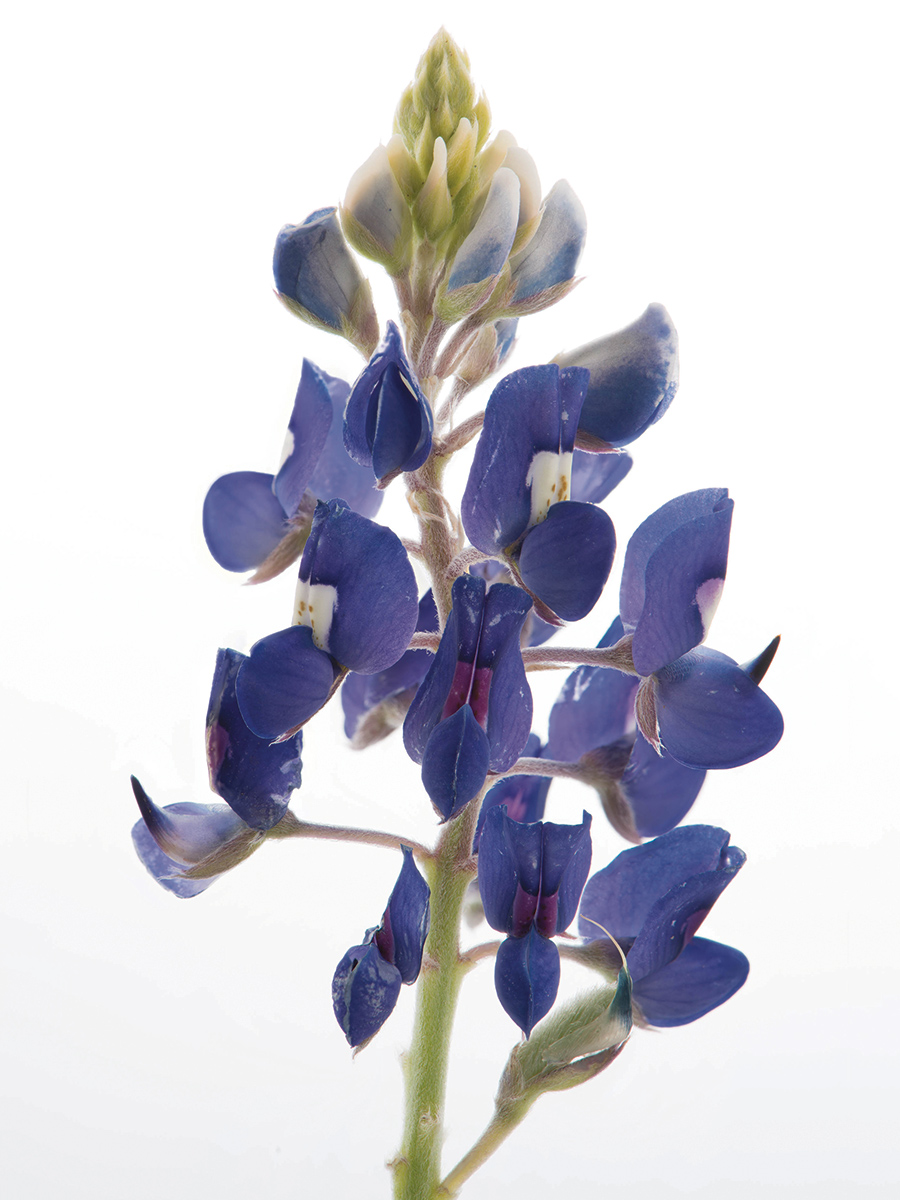Old Brides’ Tales

Bluebonnet (Lupinus texensis) PHOTO Wildflower Center
Texas bluebonnets rarely self-pollinate. If bees aren’t lured in to help, making seeds is pretty much out of the question. A wide banner petal that sits above the wing and keel petals signals to bees and other pollinating insects that a pollen reward awaits those that visit. A prominent white spot in the center of the banner does most of the heavy lifting, reflecting ultraviolet light which bees use to guide themselves toward flowers.
When a bee lands on the flower of a bluebonnet — the weight of it pushing aside the wing petals of the pealike blossom — its underbelly connects with the sex parts of the flower. Sticky pollen, which the bee came looking for, attaches to its fuzzy body. From flower to flower goes the bee, collecting protein-rich pollen that keeps smacking into its abdomen. Some of this pollen is knocked loose from the bee and deposited onto the stigmas of the flowers it visits. The pollen fertilizes the flowers’ ovules, which go on to form seeds — the only means by which Lupinus texensis, an annual plant, is able to survive from year to year.
Bluebonnets are modest flowers, keeping their sex parts enclosed within two layers of petals. After a while, their white banner spot blush pink and then purple. Flowers in this state have been called “blushing brides” and are the subject of a common misconception that banner spots turn purple as a result of the flower being pollinated. It’s a convenient narrative: A bee undresses the flower, transfers its pollen so that it can make seed babies, and the flower blushes in response.
The trouble is this this simply isn’t the case. Research published in natural history journal The Southwestern Naturalist states that banner spots of bluebonnets grown in the absence of bees still change color. After a flower has been open for five days, the 1980 study found, banner spots take on a rosy hue, which becomes completely red-purple by the sixth day. When plants were observed in both greenhouse and natural settings, bees were far more likely to visit flowers with white banner spots than purple ones. Furthermore, 6-day-old flowers that were hand-pollinated didn’t set seed, and their pollen lacked the stickiness and viability of younger flowers.
The purple banner spot on a bluebonnet is simply a sign of age and has nothing to say about whether or not the flower has been pollinated. The color change does, however, seem to help bees differentiate between a young, fertile flower and a likely infertile one. Pollinators are directed to a better pollen reward while furthering the plant’s plans to reproduce. But why hold on to old flowers anyway? After all, lots of other plant species lose their petals shortly after being pollinated.
Findings from another study, published nine years later in Evolution, looked at a different lupine species, silvery lupine (Lupinus argenteus), which holds on to infertile flowers for several days. After comparing groups of plants whose spent flowers had been removed to those whose were retained, more pollinators were observed visiting plants with more flowers, despite the fact that many of those flowers offered no reward. Retaining old flowers helps bring in more bees; color then guides them to the best flowers.
The relationship between a plant and its pollinators is among the most intimate found in nature. Bluebonnets are no exception. They rely on the help of pollinators to reproduce, their banner spots specifically designed to lure in bees. By retaining old flowers, banner spots blushing but still useful, the plant gives everything it has to get bees to notice it. While the color change of its banner spot may not signal successful pollination, it does remind us just how important pollinators are — and the lengths to which plants will go to attract them.
Daniel Murphy is collections curator at Idaho Botanical Garden and founder of Awkward Botany, a plant science blog. A punk rock fan and zine writer, he often cheers for the underdog and enjoys researching, photographing and writing about weeds.
